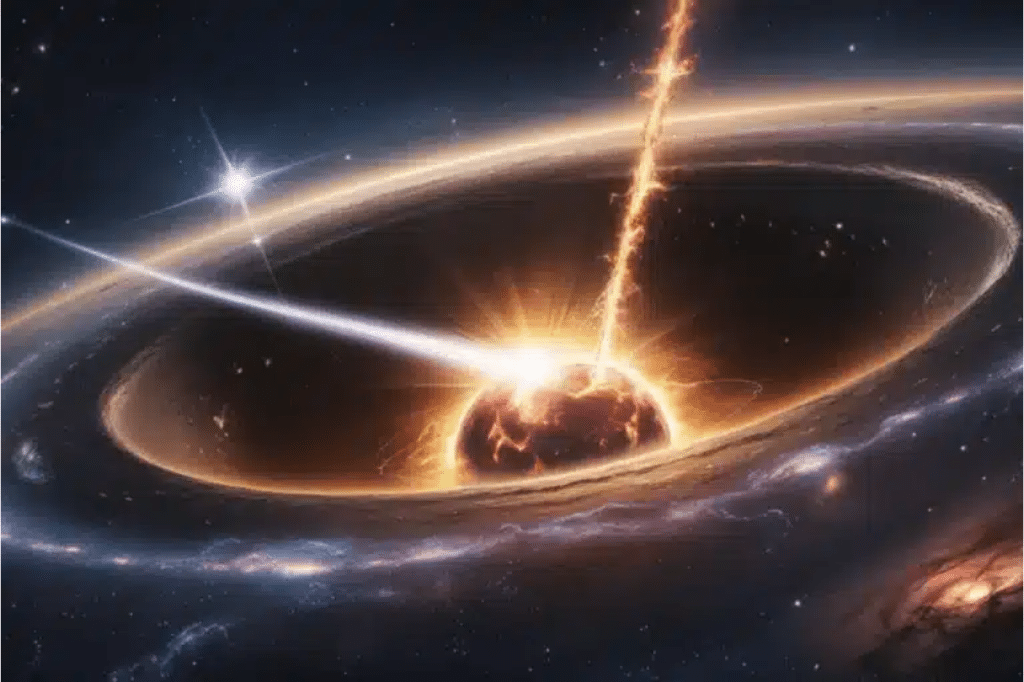Astronomers have uncovered a cosmic spectacle that may forever change how we understand black holes. Recent research has revealed supermassive black holes devouring stars three times heavier than our Sun in some of the most powerful explosions since the Big Bang. These discoveries, made by a team from the University of Hawaii, show that these black holes are not only much more massive than previously thought, but they also unleash energy beyond anything seen in typical star explosions.
Unlike the dramatic supernovae that we’re used to seeing in the cosmos, these events, known as extreme nuclear transients, are far rarer and significantly more intense. These transients occur when a supermassive black hole “wakes up” from its slumber, devouring a massive star and glowing intensely as the energy from the shredded star is released into space. The amount of radiation produced by these rare occurrences is so extreme that one of them released 25 times more energy than the most powerful supernova recorded.
Supermassive Black Holes: The Cosmos’ Hidden Giants
Supermassive black holes, lurking in the centers of galaxies, have long fascinated scientists. These cosmic behemoths possess gravity so strong that not even light can escape, making them nearly impossible to detect unless they’re actively feeding. The event horizon acts as a point of no return, where even light and radiation cannot break free from the black hole’s immense gravitational pull.
For years, scientists have wondered how to study these elusive giants. Most supermassive black holes remain invisible unless they’re consuming gas, dust, or stars. That’s where the newly discovered extreme nuclear transients come in. These high-energy bursts are rare, but they offer astronomers an unexpected way to pinpoint black holes across vast distances in space and time.
What makes these events even more significant is their ability to act like a cosmic “spotlight”, revealing black holes that have previously remained hidden and inactive. This discovery opens up the possibility of uncovering more supermassive black holes throughout the universe, even those that have been silent for billions of years.
Three Cosmic Feasts Unveiled
In their groundbreaking study, the Hawaii-based team observed three separate instances of black holes feasting on stars. These violent events, occurring in distant galaxies, released more energy than 100 supernovae combined. One such event, dubbed “Barbie,” was spotted in 2020 by the Zwicky Transient Facility in California and became a prime example of an extreme nuclear transient.
The findings reveal how black holes can unleash energy levels that dwarf those of typical star explosions. While these events are extremely rare, their brightness allows astronomers to spot them even in galaxies that are billions of light-years away.
The Quest to Find More Black Holes
Although only about 10% of early black holes are actively consuming matter, these extreme nuclear transients offer a new path to discovering other hidden black holes. In fact, the discoveries made by the University of Hawaii’s team could help astronomers uncover many more of these enigmatic objects, even those that have remained inactive and invisible for eons.
The study also opens new insights into how black holes might have played a role in shaping galaxies. As these cosmic giants feed, they may influence the formation and evolution of galaxies, affecting how galaxies grow and behave.
This discovery is not only exciting because of the extreme forces involved but also because it offers a new way to peer deep into the universe, helping us understand the role black holes play in shaping galaxies. And as these extreme nuclear transients provide a “spotlight” for otherwise invisible black holes, they bring us closer to unlocking the mysteries of these cosmic monsters that reside at the heart of galaxies far beyond our reach.
The Path Forward
With these findings, astronomers now have a powerful tool for studying supermassive black holes from afar. The study of extreme nuclear transients is still in its early stages, but it holds great promise for revealing previously hidden aspects of the universe’s most mysterious and powerful objects. As more discoveries are made, our understanding of black holes and their impact on the cosmos could be transformed forever.
Additional Insights:
- What are Extreme Nuclear Transients?
- Extreme nuclear transients are incredibly rare cosmic events where a supermassive black hole rips apart and consumes a massive star. This process results in an intense burst of energy, which can be detected over vast distances, allowing astronomers to observe otherwise inactive black holes.
- How Common Are These Events?
- These events are extremely rare compared to supernovae or other cosmic explosions. While supernovae are the deaths of massive stars, extreme nuclear transients are an ongoing process, offering insight into the life cycle of supermassive black holes.
- Impact on Galaxy Evolution:
- As black holes consume large amounts of matter, they can release vast amounts of energy. This could affect the formation of stars in their host galaxies, potentially playing a crucial role in the overall growth of galaxies.
For more News and Informational Visit Now! Voxa Times.





